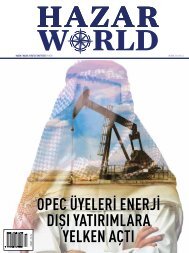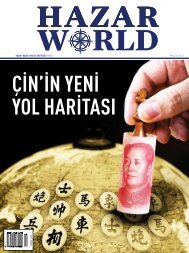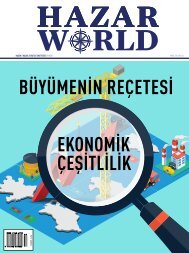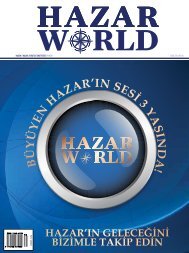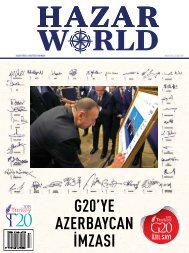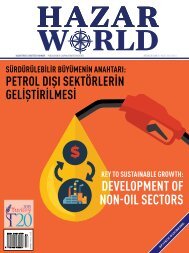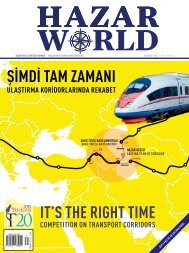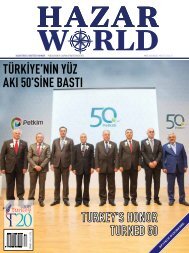You also want an ePaper? Increase the reach of your titles
YUMPU automatically turns print PDFs into web optimized ePapers that Google loves.
www.hazarworld.com<br />
ABD Ticaret Temsilcisi Michael<br />
Froman’ın da söylediği gibi, TPP<br />
Anlaşması yalnızca “Asya Pasifik<br />
bölgesi için ulaştırma kurallarının<br />
belirlenmesine [yardımcı olmakla]<br />
kalmıyor.” Bu ortaklık aynı zamanda<br />
küresel ticaret rakamları ve ekonomik<br />
büyüme üzerinde de ciddi etkilere sahip<br />
olacak çünkü TPP ülkeleri dünya<br />
GSYİH’sinin yaklaşık %40’ını oluşturuyor.<br />
Bu sebeple, söz konusu anlaşmanın<br />
taraf ülkelerce onaylanması ve yürürlüğe<br />
girmesi bir-iki yıl alacak olmasına rağmen,<br />
anlaşma siyasi ve ekonomik çevrelerde<br />
ciddi yankı buldu.<br />
TPP ANLAŞMASI’NIN EKONOMIK<br />
SONUÇLARI<br />
Tüm tercihli ticaret anlaşmaları gibi<br />
TPP Anlaşması’nın da ticaret yaratıcı<br />
ve ticaret saptırıcı etkisi olacak.<br />
Ticaret yaratıcı etki, gümrük vergileri<br />
ve gümrük dışı engellerin kaldırılması<br />
sayesinde ticaret maliyetlerinin düşmesi<br />
sonucu, anlaşmaya taraf olan ülkeler<br />
arasındaki ticaret hacminin artacağına<br />
işaret ediyor. Ticaret saptırıcı etki ise<br />
TPP dahilinde ticarete yönelik engeller<br />
kaldırılırken üçüncü ülkelere yönelik<br />
engeller varlığını koruyacağı için, TPP<br />
ülkeleri ile dünyanın geri kalanı arasındaki<br />
ticaret hacminin azalacağını ifade<br />
ediyor. TPP’nin ABD ihracatlarını %4,4,<br />
Japonya ihracatlarını ise %14 arttıracağı;<br />
aynı zamanda Çin ihracatlarını %1,2,<br />
Avrupa ihracatlarını ise %0,5 oranında<br />
düşüreceği tahmin ediliyor. Ticaret yaratıcı<br />
ve saptırıcı etkiler genellikle anlaşmaya<br />
taraf olan ülkelerdeki ekonomik<br />
refah düzeyini arttırırken, dünyanın geri<br />
kalanı için olumsuz sonuçlar doğurabilir.<br />
Bunlar, TPP’nin kısa vadede karşımıza<br />
çıkaracağı etkilerdir. Uzun vadede ise<br />
yatırımı teşvik edip verimliliği arttırarak<br />
taraf ülkelerde ekonomik büyümeyi<br />
destekleyecek ve refah düzeyini yükseltecektir.<br />
Ticarete yönelik engellerin kaldırılması<br />
sonucu ticaret maliyetleri düşecek<br />
ve bu sayede ithal ara mal maliyetleri<br />
de azalacak. Böylelikle taraf ülkelerdeki<br />
üretim maliyetleri bir hayli düşmüş<br />
olacağı için bu ülkelerde üretim artacak.<br />
Düşen maliyetler ve artan üretim, özellikle<br />
makine, ekipman, kimyasal ve petrokimyasal<br />
ürünler, elektronik ekipman<br />
ve motorlu araç imalatı gibi ölçeğe göre<br />
artan getiri sağlayan sektörlerde verimlilik<br />
artışına önemli katkı sağlayacak.<br />
TPP ÜLKELERI DÜNYA<br />
GSYİH’SININ<br />
YAKLAŞIK %40’INI<br />
OLUŞTURUYOR.<br />
TPP COUNTRIES<br />
COVER ABOUT 40% OF<br />
THE <strong>WORLD</strong>’S GDP.<br />
The TPP agreement does not only<br />
“... [help] define the rules of the<br />
road for the Asia-Pacific region”,<br />
as the US Trade Representative<br />
Michael Froman said. This partnership<br />
will also have significant impacts on<br />
the global trade flows and economic<br />
growth around the world as the TPP<br />
countries cover about 40% of the<br />
world’s GDP. Therefore, the mere announcement<br />
of this deal has caused<br />
huge reflections both in political and<br />
economic circles, although ratification<br />
by participating countries, and hence<br />
entrance into force of the agreement<br />
may take one or two years.<br />
ECONOMIC CONSEQUENCES OF THE<br />
TPP AGREEMENT<br />
The TPP Agreement, like any preferential<br />
trade agreement, will have trade<br />
creation and trade diversion effects.<br />
The first effect consists of generating<br />
greater trade flows between the participating<br />
countries as result of reduction<br />
of trade costs due to elimination of<br />
tariffs and non-tariff barriers. The second<br />
effect will be to reduce trade flows<br />
between TPP countries and the rest of<br />
the world as the trade barriers against<br />
third countries with TPP participants<br />
will remain unchanged while those<br />
within TPP will be eliminated. In fact,<br />
it is estimated that TPP will increase<br />
US exports by 4.4% and Japanese exports<br />
by 14% whereas reduce Chinese<br />
exports by 1.2% and European exports<br />
by 0.5%. Trade creation and diversion<br />
effects generally increase economic<br />
welfare in the participating countries<br />
while may be detrimental to the economies<br />
of the rest of the world.<br />
These effects are short-run effects of<br />
the TPP. In the longer run the TPP will<br />
enhance economic growth, and hence<br />
well-being, further in the participating<br />
countries by promoting investment<br />
and increasing efficiency. Removal of<br />
trade barriers will reduce trade costs,<br />
which implies reduction of cost of<br />
imported intermediate goods. This<br />
will ultimately bring down production<br />
costs in the participating countries<br />
and thus increase production in these<br />
countries. Falling costs and increasing<br />
production will lead to efficiency gains,<br />
especially in industries such as manufacture<br />
of motor vehicles, machinery<br />
<strong>HAZAR</strong> <strong>WORLD</strong><br />
15



